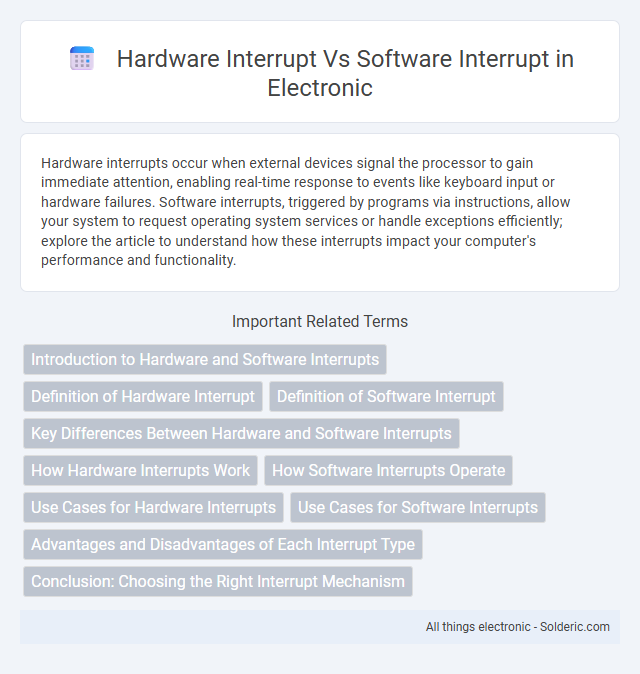Hardware interrupts occur when external devices signal the processor to gain immediate attention, enabling real-time response to events like keyboard input or hardware failures. Software interrupts, triggered by programs via instructions, allow your system to request operating system services or handle exceptions efficiently; explore the article to understand how these interrupts impact your computer's performance and functionality.
Comparison Table
| Feature | Hardware Interrupt | Software Interrupt |
|---|---|---|
| Source | External hardware devices (e.g., keyboard, mouse) | Program instructions or system calls |
| Triggering | Signal from hardware component to CPU | Execution of an interrupt instruction in software |
| Purpose | Respond to external events in real-time | Request OS services or handle exceptions |
| Latency | Typically low, depends on hardware priority | Usually higher due to software execution |
| Handling | Interrupt Service Routine (ISR) invoked by hardware | Handled by OS via software interrupt handler |
| Examples | Timer interrupt, I/O device interrupt | System calls like INT 0x80 in Linux |
| Interrupt Vector | Fixed by hardware and CPU architecture | Defined by software and OS design |
Introduction to Hardware and Software Interrupts
Hardware interrupts are signals generated by external devices like keyboards or network cards to immediately capture the CPU's attention for urgent processing. Software interrupts, triggered by executing specific instructions within a program, facilitate system calls and communication between different software components. Both types of interrupts improve system efficiency by enabling prompt and organized responses to various events.
Definition of Hardware Interrupt
A hardware interrupt is a signal sent from an external device to the processor, prompting it to pause its current execution and address a high-priority task immediately. This mechanism allows peripherals like keyboards, mice, or network cards to communicate urgent needs directly to the CPU. Understanding hardware interrupts helps you optimize system responsiveness and manage real-time processing efficiently.
Definition of Software Interrupt
A software interrupt is a signal generated by a program or operating system to temporarily halt the CPU and request specific processing, enabling communication between software and hardware or system calls. Unlike hardware interrupts triggered by external devices, software interrupts are controlled internally by executing specific instructions, such as INT in x86 architecture. These interrupts facilitate efficient execution of system services, debugging, and context switching within the CPU.
Key Differences Between Hardware and Software Interrupts
Hardware interrupts are triggered by external devices such as keyboards, mice, or network cards to signal the CPU to handle urgent tasks immediately. Software interrupts, also known as traps or exceptions, are initiated by executing instructions within a program to request operating system services or signal specific conditions. The primary differences lie in their sources--hardware interrupts originate externally, while software interrupts arise internally--and in their handling mechanisms, where hardware interrupts often involve dedicated interrupt lines and prioritization, contrasting with software interrupts managed through instruction execution and context switching.
How Hardware Interrupts Work
Hardware interrupts are signals generated by external devices such as keyboards, mice, or network cards to immediately alert the CPU of an event requiring attention. When a hardware interrupt occurs, the processor pauses its current execution, saves its state, and jumps to a specific interrupt handler routine to process the event. This mechanism ensures timely response to real-world events, improving system efficiency and multitasking capabilities.
How Software Interrupts Operate
Software interrupts operate through special processor instructions that trigger specific interrupt service routines, allowing programs to request operating system services or handle internal events. These interrupts use interrupt vectors to access predefined handlers, enabling controlled execution of system calls or exceptions without involving external hardware signals. Software interrupts provide a mechanism for synchronous communication between user applications and the operating system, enhancing efficient resource management and process control.
Use Cases for Hardware Interrupts
Hardware interrupts are critical in managing time-sensitive tasks such as input from keyboards, mice, and network interfaces, ensuring immediate CPU attention for real-time processing. They are extensively used in embedded systems, allowing devices like sensors and communication modules to promptly signal the processor upon event detection. Your system relies on hardware interrupts to efficiently handle asynchronous events without continuous polling, improving overall performance and responsiveness.
Use Cases for Software Interrupts
Software interrupts are primarily used for system calls, enabling user applications to request services from the operating system kernel efficiently. They facilitate exception handling, such as division by zero or invalid memory access, allowing programs to respond to errors gracefully. Debugging and context switching in multitasking operating systems also rely on software interrupts to manage execution flow and resource allocation.
Advantages and Disadvantages of Each Interrupt Type
Hardware interrupts offer immediate response to external events, enhancing system efficiency and real-time processing capabilities, but they can introduce complexity in handling multiple interrupt sources and may cause priority inversion issues. Software interrupts provide controlled and programmable interrupt service routines, simplifying debugging and system calls, yet they generally have higher latency and rely on CPU scheduling, which may delay critical task execution. Balancing hardware and software interrupts is crucial for optimizing system performance, with hardware interrupts excelling in time-sensitive scenarios and software interrupts providing flexibility in managing internal processes.
Conclusion: Choosing the Right Interrupt Mechanism
Hardware interrupts provide immediate response to external events by signaling the processor directly, making them ideal for time-sensitive tasks such as input/output operations. Software interrupts, triggered by programs to request system services, offer controlled and flexible management of process execution without relying on external signals. Your choice of interrupt mechanism should align with the urgency of the task and system design, prioritizing hardware interrupts for real-time responsiveness and software interrupts for routine process control.
hardware interrupt vs software interrupt Infographic

 solderic.com
solderic.com